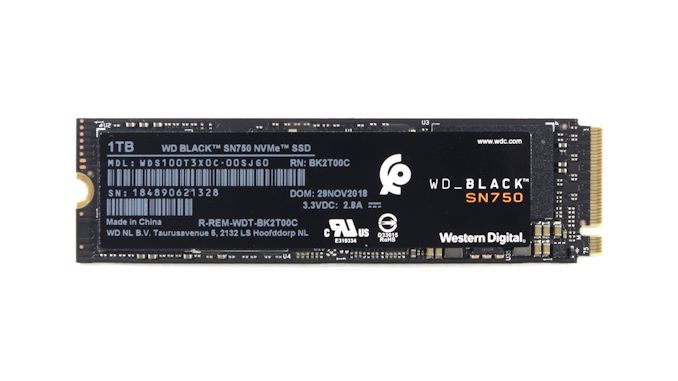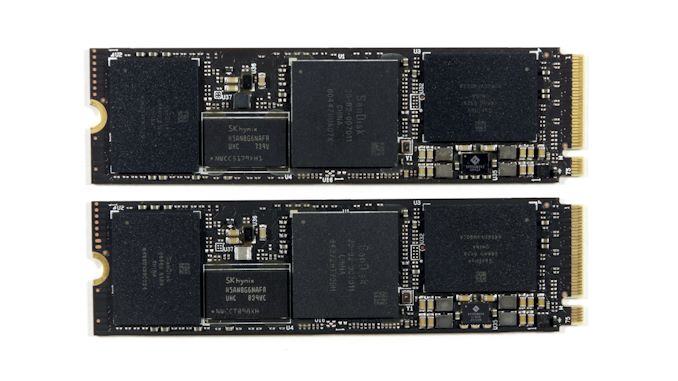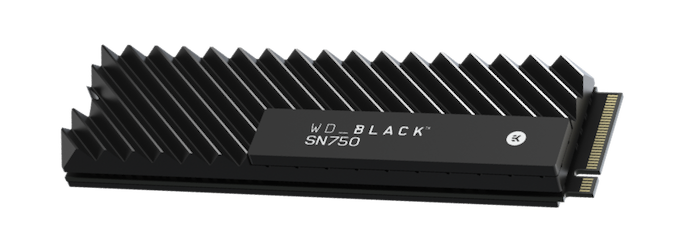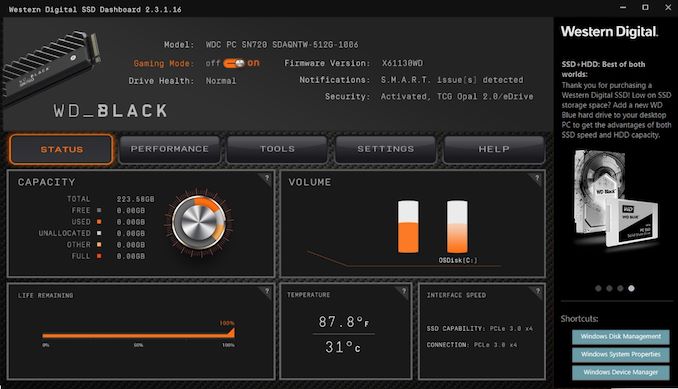The Western Digital WD Black SN750 SSD Review: Why Fix What Isn't Broken?
by Billy Tallis on January 18, 2019 8:01 AM EST
Last year Western Digital overhauled their WD Black NVMe SSD with an upgrade to 3D NAND and a new in-house SSD controller, transforming the product line from one of the slowest NVMe drives to one of the top high-end competitors. Now the third generation WD Black SSD is here, with the model number SN750 to avoid confusion with its predecessors. (Internally, last year's model was known as the SN700, and the OEM version was the SN720.) The new WD Black SN750 is an incremental update over last year's model, keeping the same basic controller and 64L 3D NAND combination but refining the firmware and adding a 2TB option. Western Digital is also shifting their marketing efforts more toward gamers with the addition of SKUs featuring a large heatsink.
The second-generation WD Black launched last year delivered performance that is generally competitive with other top NVMe SSDs like the Samsung 970 EVO, while usually operating with far better power efficiency. The only other high-end NVMe SSDs that have similar efficiency are the Toshiba XG5 and XG6, but the controller they use puts them clearly in a lower performance class than the WD Black. However, last year's model was still the first release of a new controller architecture, so it is no surprise that Western Digital has some firmware improvements to deliver. It is a bit disappointing that those improvements aren't being distributed as free firmware updates to owners of last year's model, but Western Digital is not the only company that's taken this approach.
| Western Digital WD Black SN750 Specifications | ||||||
| Capacity | 250 GB | 500 GB | 1 TB | 2 TB | ||
| Form Factor | M.2 2280 single-sided optional heatsink (except 250GB) |
|||||
| Interface | PCIe 3 x4 NVMe 1.3 | |||||
| Controller | Western Digital in-house | |||||
| NAND Flash | SanDisk 64-layer 3D TLC | |||||
| Sequential Read | 3100 MB/s | 3470 MB/s | 3470 MB/s | 3400 MB/s | ||
| Sequential Write | 1600 MB/s | 2600 MB/s | 3000 MB/s | 2900 MB/s | ||
| Random Read | 220k IOPS | 420k IOPS | 515k IOPS | 480k IOPS | ||
| Random Write | 180k IOPS | 380k IOPS | 560k IOPS | 550k IOPS | ||
| Power | Peak | 9.24 W | 9.24 W | 9.24 W | 9.24 W | |
| PS3 Idle | 70 mW | 70 mW | 100 mW | 100 mW | ||
| PS4 Idle | 2.5 mW | 2.5 mW | 2.5 mW | 2.5 mW | ||
| Warranty | 5 years | |||||
| Write Endurance | 200 TB 0.4 DWPD |
300 TB 0.3 DWPD |
600 TB 0.3 DWPD |
1200 TB 0.3 DWPD |
||
| MSRP (No heatsink) |
$79.99 | $129.99 | $249.99 | $499.99 | ||
Aside from the addition of the 2TB option, the most noticeable changes to the specs table are the vastly lower MSRPs: the 2TB will debut for only $50 more than the 1TB model was at introduction last year, and the smallest price drop is the 33% cut to the 250GB model's price tag.
Performance has been improved slightly across most of the major metrics, but none of the improvements are anything huge. The 2TB model will actually be slightly slower than the 1TB, due in part to using 512Gb NAND dies instead of 256Gb dies so that the 2TB model can still be a single-sided M.2 card.
The 2TB model and the SKUs equipped with heatsinks will be arriving this spring, but the plain 250GB through 1TB models ship this month. Western Digital has not provided MSRPs for the models with heatsinks, but we expect them to carry a bit of a premium when they arrive.
Peeking under the label, we find essentially the same PCB as last year's model, though it appears we've gone from revision A to revision D. The WD Black SN750 is equipped with the same controller and NAND parts as last year's WD Black and SanDisk Extreme Pro, and the only differences in chip markings appear to be date codes or lot numbers.

Top: 2nd Gen WD Black (SN700)
Bottom: 3rd Gen WD Black SN750
Unlike last year's model, the new WD Black SN750 does not have a sibling product under the SanDisk brand; the SanDisk Extreme Pro NVMe SSD is now strictly speaking an outdated product, though it is still very similar to the new WD Black.
Western Digital has made a few superficial changes to the WD Black to make it more gamer-oriented. The product packaging and labeling has been restyled, and all but the smallest model will soon be available in versions with a custom aluminum heatsink from EKWB. Additionally, there's a new version of Western Digital's new SSD Dashboard software for Windows that adds a "Gaming Mode" which re-configures the NVMe driver to not enable Autonomous Power State Transitions. When this gaming mode is enabled, the drive won't make use of its low-power idle states, which avoids the extra latency of waking the drive up after it has been idle for a few seconds. However, in our experience few gaming desktops are configured to use the deepest idle states, and the WD Black wakes up very quickly from its intermediate idle, so this feature will be inconsequential for most users.
Our Linux-based synthetic performance tests are already conducted with APST off so that idle wake-up latency doesn't distort those results. Our Windows-based ATSB trace tests leave APST enabled, but the trace playback cuts idle times short enough that most NVMe drives won't be entering low-power states during those tests, either. The SYSmark 2018 test gives SSDs plenty of idle time to make use of their deepest idle states, but overall the workload it presents is not storage-intensive enough for WD's Gaming Mode to have a noticeable effect.
It may seem odd that Western Digital is sticking with their 64-layer 3D NAND even months after their partner Toshiba started shipping 96L 3D NAND with the XG6, but the transition to 96L NAND will look very different from the transition to 64L NAND. The 64L generation leveled the playing field as Toshiba and Western Digital delivered their first 3D NAND worth mass producing, and Intel and Micron made significant performance improvements over their previous 32L NAND. As most of the major manufacturers largely caught up to Samsung and ramped up production, prices crashed. That's been great news for consumers, but has prompted the manufacturers to slow their investments into 96L production to avoid worsening the oversupply. Thus, we expect the 96L transition to proceed more slowly, taking all of 2019 and probably into 2020 before every 64L product line gets upgraded. The 96L upgrade has the potential to bring some significant performance and power improvements, but will in most cases require a new generation of controllers that can take advantage of higher controller-to-NAND interface speeds or lower operating voltages.
Since last year's WD Black launched, the most important new competitors to hit the scene have been drives based on Intel/Micron NAND with the SM2262 controller, and drives using the same Toshiba/SanDisk NAND with the Phison E12 controller. The SM2262 drives (represented in this review by the HP EX920) are now being phased out in favor of the upgraded SM2262EN controller, which we previewed last year. Representing the Phison E12 family, we have the Corsair Force MP510 960GB.
| AnandTech 2018 Consumer SSD Testbed | |
| CPU | Intel Xeon E3 1240 v5 |
| Motherboard | ASRock Fatal1ty E3V5 Performance Gaming/OC |
| Chipset | Intel C232 |
| Memory | 4x 8GB G.SKILL Ripjaws DDR4-2400 CL15 |
| Graphics | AMD Radeon HD 5450, 1920x1200@60Hz |
| Software | Windows 10 x64, version 1709 |
| Linux kernel version 4.14, fio version 3.6 | |
| Spectre/Meltdown microcode and OS patches current as of May 2018 | |
- Thanks to Intel for the Xeon E3 1240 v5 CPU
- Thanks to ASRock for the E3V5 Performance Gaming/OC
- Thanks to G.SKILL for the Ripjaws DDR4-2400 RAM
- Thanks to Corsair for the RM750 power supply, Carbide 200R case, and Hydro H60 CPU cooler
- Thanks to Quarch for the XLC Programmable Power Module and accessories
- Thanks to StarTech for providing a RK2236BKF 22U rack cabinet.
















54 Comments
View All Comments
joesiv - Friday, January 18, 2019 - link
Micron was the manufacturer I was referring to.Other brands we've used which didn't exhibit the same poor endurance, ADATA, Kingston, Swissbit, Crucial
Some of them probably even use Micron NAND. I bet the NAND is fine on the Micron model we were using, perhaps the hardware is good but the software (firmware) wasn't? Of course we haven't tested every brand/model as our requirements were very specific, so I am sure there are other Micron models that are totally fine (kind of why i'd love to see anandtech include some endurance results, to help weed out the outliers)
sdsdv10 - Friday, January 18, 2019 - link
Interesting you write that Micron has problems and Crucial doesn't, as Crucial is just a consumer brand name for Micron Technology Inc.joesiv - Friday, January 18, 2019 - link
Well they were different models. The crucial was an old model that we were replacing with something new, since the old crucial drives were no longer available. It would be interesting to compare a crucial equivalent model though, I wonder if they share firmware.sovking - Friday, January 18, 2019 - link
Of course, these improvement will be welcomed, and I would like to see more in clear the steady state behaviour too.Regarding the endurance, we should take into account that most of these reviews are about consumer products. An NVME SSD for enterprise market has totally different performance: e.g regular steady state performance, higher endurance, higher reliability and so on. Sometimes, it's possible to find lightly used enterprise NVME drives at bargain price or at the cost of consumer drive: when this happens I prefer these drives.
joesiv - Friday, January 18, 2019 - link
I think the role of a "consumer" is not perfectly defined these days. Are they the same as a "power user?" It would seem that more and more consumers are starting to do more and more serious workloads on their PCs. Obviously this is anecdotal, but with all the processing power at our disposal these days ("consumer" CPU's having 16 threads). People probably don't even know what the applications or services that they are running on their PC are doing.For example, a lot of commonly used applications will be running with a database system as their backend, whether it be a more simple sqlite database, or something more serious, those can be very write heavy, and they're often configured by the application without the user even knowing it. I'll bet that a lot of users even have web services running on their PC's, without actually thinking about it, all these API's that allow you to connect to your mobile devices/streaming appliances.
I'll bet a lot of people reading anandtech reviews even have their PC's running as a fileserver, or have a dedicated machine for such duties.
A lot of this stuff is stuff is stuff would be considered "enterprise" computing of yester-years. Why does anandtech run transcoding, rendering and "destroyer" style tests in their "consumer" reviews? Because it's relevant to some portion of the purchasing community.
Oxford Guy - Friday, January 18, 2019 - link
Considering how consumer parts have had endurance problems...Examples: OCZ Vertex 2 (with 64-bit NAND), Samsung 840 128 (terrible steady state performance, too), Samsung 840 and 840 EVO series (read speed loss), etc.
Endurance isn't just a matter of whether or not the drive dies or it has a lot of cell death. It's also a matter of performance consistency over time.
joesiv - Friday, January 18, 2019 - link
I agree, I have bad memories of the early days of SSD's. I purchased a first generation intel SSD for $1000 (CND), the speeds were tested as being amazing compared to anything else on the market. But given the early learning curves with NAND controllers, and whatever the like, performance was terrible in the real world. I wasn't even able to upgrade the firmware since it was a first generation product, and only the subsequent versions supported the updates.Things have gotten better, but from my experience, it's been a rough road. Some manufacturers are a lot better than others for firmware development, and believe it or not a bug in the firmware can tank performance, or even tank your reliability, since the firmware is what controls wear leveling, and other new fangled features to give the maximum performance.
There are MLC drives that work in SLC mode dynamically to aid in performance, and other drives that are MLC NAND running SLC mode which have a hybrid endurance between the two. Some older drives did driver level compression to reduce NAND writes, while theoretically great, can cause problems for reliability if there are any cases where the data doesn't get committed correctly, especially in poor power conditions. Firmware bugs are rarely talked about, but a firmware bug could cause garbage collection to occur too often, which will take your performance and reliability.
gglaw - Friday, January 18, 2019 - link
With current gen 3D NAND, it would take an incredible amount of writes to test endurance and the regional wholeseller RMA data averaged over hundreds of thousands of SSD's sold is much more representative than AT testing endurance on 1 drive they receive as a sample. It appears most SSD RMA's are NOT from using up the endurance cycles so that would make a 1 sample test by AT even less meaningful. If they happen to get a dud when 99% of that same model has a very good reliability history based on the broader market it would just make thousands of AT readers base their purchasing decision based on a sample size of 1.Billy Tallis - Friday, January 18, 2019 - link
P/E ratings are highly dependent on what kind of error correction the NAND is used with. Even under pressure, the NAND manufacturers won't be able to give us more than just ballpark figures that would be tough to fairly compare between manufacturers.Last year (I think around when the first QLC drives showed up) I started recording SMART data before and after each phase of testing. I haven't written any code to parse and analyze that information yet, but it's on my to-do list.
I don't think the usual consumer SSD test suite does enough total drive writes to move the SMART indicators enough to form meaningful projections about write endurance and drive lifetime. To do that, I would have to set up another system to do long-term endurance testing on several drives at once. That's also on our wishlist, but it's a relatively low priority given the extra equipment and time requirements.
joesiv - Friday, January 18, 2019 - link
@gglaw, @Billy Tallis, you guys are right, it's hard to get firm reliability numbers based off a short, small sample test. But to be honest, its' better than nothing. And as I said, seeing one example of an outlier that performs badly on the bench for the test would validate it's usefulness.gglaw, you are totally right, there is more to reliability than PE Cycles, I gave the examples of a drive that under our testing failed, with a life expectancy under a year, the same test scenario (which was a heavy real world workload for our product) on other similar rated drives did not fail the test. But I didn't mention that we had huge realiability issues with our previous drives (Kingston), where they were no where near the end of their endurance ratings, but were failing for other causes. Kingston attributed a lot of the failures to firmware bugs that weren't traceable in SMART data, and in some cases pure hardware failure.
Billy, yes in general you're right, it's hard to get meaningful projections for a short period of time, this is especially the case if you use percent life used as a metric (1-100). However, it's not too bad if you can get the PE Cycles, which typically are 3000 for MLC, and in some cases 2500 for 3D NAND, instead of waiting months for a single change in percent life change, we have seen drives go through 1 PE Cycle a day, which would give us around 8 years of product life (baring other failures), we were going through 5-6 PE Cycles a day on the Micron drive, which was a huge warning sign. That would be a great case for anandtech finding the poor endurance outliers.